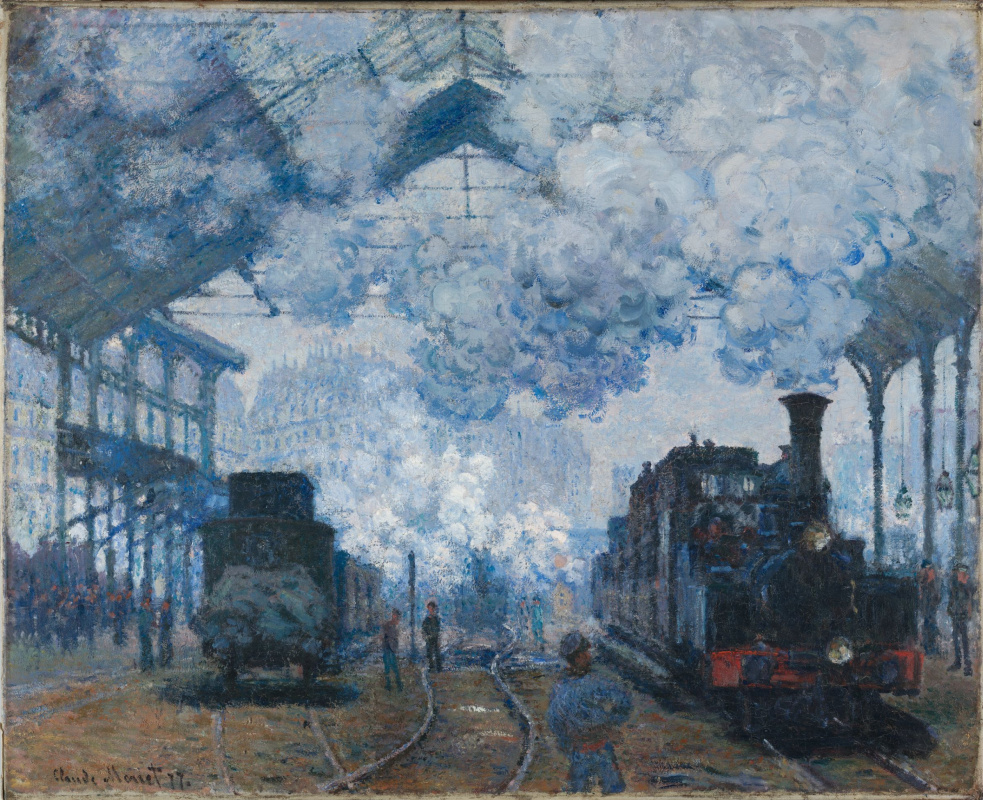log in
Enter site
Login to use Arthive functionality to the maximum
Arrival of the Normandy Train, Gare Saint-Lazare
Claude Monet • Painting, 1877, 81.9×101 cm
Description of the artwork «Arrival of the Normandy Train, Gare Saint-Lazare»
Monet was born in 1840, and only two years after his birth, the construction of a passenger railway was allowed by the French law. The government issued the corresponding charter and made contracts with various companies for the implementation of the most important construction of the 19th century. By 1914, the French railway became one of the most developed in the world, and the total length of the tracks was 60 thousand kilometres. It was a revolution that set a completely new pace of life, opened up a new view of the world.
Somewhere in the middle of this rapid railway development, in 1877, trains became a new obsession of 37-year-old Claude Monet. In the French fine arts, a new topic opened up, bold and deliberately doomed to be misunderstood by the contemporaries. Monet’s industrial landscapes angered critics to gnashing teeth, they vied with each other in derogatory characteristics. For example, the following passage appeared on the pages of Figaro: “On the whole, Claude Monet managed to accurately convey the extremely unpleasant impression that the simultaneous whistling of several steam locomotives produced on us.”
That year, the artist rented a small studio near the Gare Saint-Lazare in Paris, where he hid some of his paintings from creditors. Claude Monet was so captivated by the sight of smoking steam locomotives that he decided on a new series; this time he made it in the very heart of the modern city. But Monet was not used to painting from memory.
The painter’s son, Jean Renoir, in his book dedicated to his father and his entourage, recalled how Claude Monet set up a studio right at the station. “They will have to delay the Rouen train: the lighting is much better half an hour after its departure,” the artist decided. Further were the technicalities. Monet put on his best suit, a shirt with lace cuffs, and went to conquer his new plein air. Toying with a chic cane, he announced to the director: “I am the artist Claude Monet. I decided to paint your station! I hesitated for a long time which of the two stations to choose — the Gare du Nord or yours, but finally settled on yours, it is more characteristic!” Anyone who would have seen him then thought he was doing a great honour to the station and personally to the director. For Monet, trains were delayed, platforms were cleared, and the right amount of smoke was released at the right time of day. The result of this performance was 12 paintings (see the whole series), which were immediately bought by the art dealer Paul Durand-Ruel: he was an amazingly perspicacious connoisseur of art and bought Monet’s paintings several decades before they began to bring money and fame.
Written by Anna Sidelnikova
Somewhere in the middle of this rapid railway development, in 1877, trains became a new obsession of 37-year-old Claude Monet. In the French fine arts, a new topic opened up, bold and deliberately doomed to be misunderstood by the contemporaries. Monet’s industrial landscapes angered critics to gnashing teeth, they vied with each other in derogatory characteristics. For example, the following passage appeared on the pages of Figaro: “On the whole, Claude Monet managed to accurately convey the extremely unpleasant impression that the simultaneous whistling of several steam locomotives produced on us.”
That year, the artist rented a small studio near the Gare Saint-Lazare in Paris, where he hid some of his paintings from creditors. Claude Monet was so captivated by the sight of smoking steam locomotives that he decided on a new series; this time he made it in the very heart of the modern city. But Monet was not used to painting from memory.
The painter’s son, Jean Renoir, in his book dedicated to his father and his entourage, recalled how Claude Monet set up a studio right at the station. “They will have to delay the Rouen train: the lighting is much better half an hour after its departure,” the artist decided. Further were the technicalities. Monet put on his best suit, a shirt with lace cuffs, and went to conquer his new plein air. Toying with a chic cane, he announced to the director: “I am the artist Claude Monet. I decided to paint your station! I hesitated for a long time which of the two stations to choose — the Gare du Nord or yours, but finally settled on yours, it is more characteristic!” Anyone who would have seen him then thought he was doing a great honour to the station and personally to the director. For Monet, trains were delayed, platforms were cleared, and the right amount of smoke was released at the right time of day. The result of this performance was 12 paintings (see the whole series), which were immediately bought by the art dealer Paul Durand-Ruel: he was an amazingly perspicacious connoisseur of art and bought Monet’s paintings several decades before they began to bring money and fame.
Written by Anna Sidelnikova


